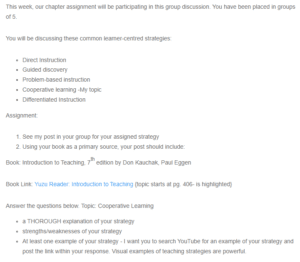Cooperative Learning
Cooperative learning is a learning strategy that organizes classroom activities into social and academic learning experiences. Even if cooperative learning is founded on group work, it is much more than simply organizing learners into groups because students will have to work collaboratively or as a team on a structured activity. However, each group member is responsible for their individual work. The entire group’s work is also evaluated (Kauchak & Eggen, 2015). Groups in cooperative learning work face-to-face, and learners learn to work in a group. There are different examples of cooperative learning. They include jigsaw II and think-share pair share strategy.
Cooperative learning has strengths and weaknesses. Its strengths are it boosts students’ success and improves their problem-solving and interpersonal skills (Kauchak & Eggen, 2015). Besides, cooperative learning increases learning motivation. Essentially, when employed effectively, cooperative learning engages all learners, which can be challenging in whole-class activities where less confident students have fewer chances to participate. Conversely, the weaknesses of cooperative learning are that it cannot increase motivation, in some cases, and achievement. For example, when learners are arranged into mixed-ability groups, those with higher abilities often feel demoralized and prefer working alone instead of in groups. Also, average-ability learners often fail to take advantage of learning in mixed-ability groups, as high-ability learners often dominate group interactions.
One example of cooperative learning is jigsaw II learning. Jigsaw II is a cooperative learning activity that tutors use in class, where learners are required to research one section of the material and then teach it to other group members. A perfect example is presented in the YouTube link: https://www.youtube.com/watch?v=mtm5_w6JthA. In the Jigsaw II method, learners are grouped into home and expert groups using numbers, and each student is to research a specific topic. The expert group members then return to their home groups and teach the group members about the researched topic (Cult of Pedagogy, 2015). It is evident from the video that once learners sit back together in class, they are more engaged and motivated to learn. Therefore, cooperative learning, especially the jigsaw II method, increases motivation, student engagement, achievement, and collaboration among students in class.
References
Cult of Pedagogy (2015). The Jigsaw Method. https://www.youtube.com/watch?v=mtm5_w6JthA.
Kauchak, D., & Eggen, P. (2016). Introduction to teaching: Becoming a professional. Pearson.
ORDER A PLAGIARISM-FREE PAPER HERE
We’ll write everything from scratch
Question

Cooperative Learning
This week, our chapter assignment will be participating in this group discussion. You have been placed in groups of 5.
You will be discussing these common learner-centered strategies:
- Direct Instruction
- Guided discovery
- Problem-based instruction
- Cooperative learning -My topic
- Differentiated Instruction
Assignment:
- See my post in your group for your assigned strategy
- Using your book as a primary source, your post should include:
Book: Introduction to Teaching, 7th edition by Don Kauchak, Paul Eggen
Book Link: Yuzu Reader: Introduction to Teaching {topic starts at pg. 406- is highlighted}
Answer the questions below. Topic: Cooperative Learning
- A THOROUGH explanation of your strategy
- Strengths/weaknesses of your strategy
- At least one example of your strategy – I want you to search YouTube for an example of your strategy and post the link within your response. Visual examples of teaching strategies are powerful.

